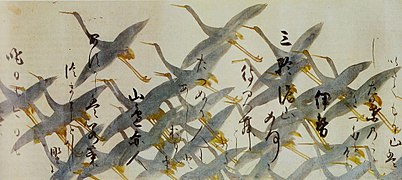Hon'ami Kōetsu
Hon'ami Kōetsu ( Japanese 本 阿 弥 光 悦 ; born 1558 ; died February 27, 1637 ) was a Japanese calligrapher and potter, one of the "three calligraphers of the Kan'ei period".
life and work
The members of the Hon'ami family were sword sharpeners and polishers as well as judges of swords. Little is known about the youth of Kōetsu, but he must have grown up in an environment that was not only concerned with swords, but also with arts and crafts in general. He seems to have had a lot of freedom and was able to pursue his artistic inclinations. He had a large circle of acquaintances, both in the sword aristocracy and in business circles, knew doctors, tea masters, manufacturers of lacquer work, swords and the potters of the raku family. From these acquaintances he developed his own artistic ideas.
A particularly important friendship was that with Suminokura Soan ( 角 倉 素 庵 ; 1571–1632). He was not only an entrepreneur and developer active in foreign trade, but also an art connoisseur and publisher of expensive books, known as Sagabon ( 嵯峨 本 ). Soan published these books in the Keichō period (1598–1615) and seems to have relied on Kōetsu, who was already a mature calligrapher at the time and contributed the calligraphy for the books.
Initially, Kōetsu was primarily concerned with calligraphy, but later in life he also turned to pottery. In part, this is due to the fact that he was affected by paralysis from 1610 onwards. He left downtown Kyoto and settled in Taka-ga-mine ( 鷹 ヶ 峰 ) in the north of the city, where Tokugawa Ieyasu had allotted him a piece of land. There he began his work as a potter, following the raku tradition, even if his tea bowls differ greatly according to his character. He was based on Tanaka Sōkei ( 田中 宗慶 ; 1525–?) And worked with a certain Nonkō from the Raku family. He encouraged other potters to settle there too, creating a kind of artisans' settlement, which, however, dissolved after his death.
photos
Remarks
- ↑ Tea bowl, called " Mount Fuji " ( 不二 山 , Fujisan), national treasure , owned by the Suntory Art Museum .
- ↑ The three calligraphers ( 寛 永 の 三 筆 , Kan'ei no sampitsu) also included Konoe Nobutada and Shōkadō Shōjō .
- ↑ These saga books, named after the suburb of Saga in Kyoto, were an attempt to print hiragana texts with movable type. The result was aesthetically pleasing, but the edition was not continued.
- ↑ From the anthology of 100 poets. Sōtatsu underground.
- ↑ Lacquer work, decorated with an inscribed, applied metal band.
- ^ In the possession of the Museum of Asian Art (Berlin) . Gold background designed by Tawaraya Sōtatsu .
literature
- S. Noma (Ed.): Hon'ami Kōetsu . In: Japan. An Illustrated Encyclopedia. Kodansha, 1993, ISBN 4-06-205938-X , p. 555
- Tazawa, Yutaka: Hon'ami Kōetsu . In: Biographical Dictionary of Japanese Art. Kodansha International, 1981. ISBN 0-87011-488-3 .
- Laurance P. Roberts: Hon'ami Kōetsu . In: A Dictionary of Japanese Artists. Weatherhill, 1976. ISBN 0-8348-0113-2 .
- Mizuo, Hiroshi: Edo Painting: Sotatsu and Korin. Weatherhill / Heibonhsha, Tokyo, 1972. ISBN 0-8348-1011-5 .
Web links
| personal data | |
|---|---|
| SURNAME | Hon'ami, Kōetsu |
| ALTERNATIVE NAMES | 本 阿 弥 光 悦 (Japanese) |
| BRIEF DESCRIPTION | Japanese painter |
| DATE OF BIRTH | 1558 |
| PLACE OF BIRTH | Kyoto |
| DATE OF DEATH | February 27, 1637 |
| Place of death | Kyoto |






